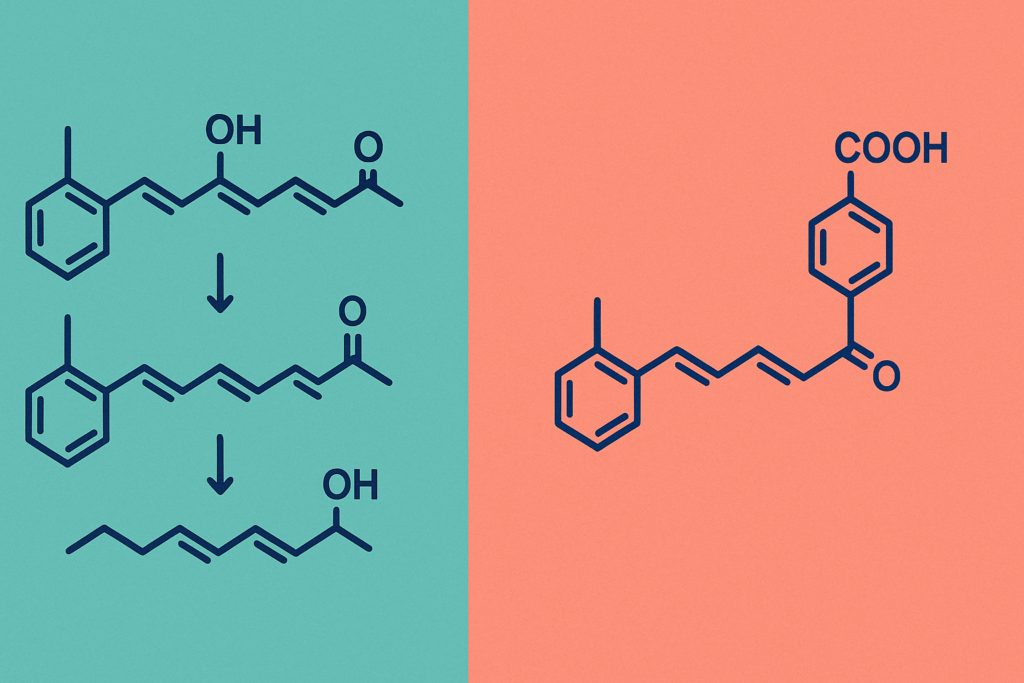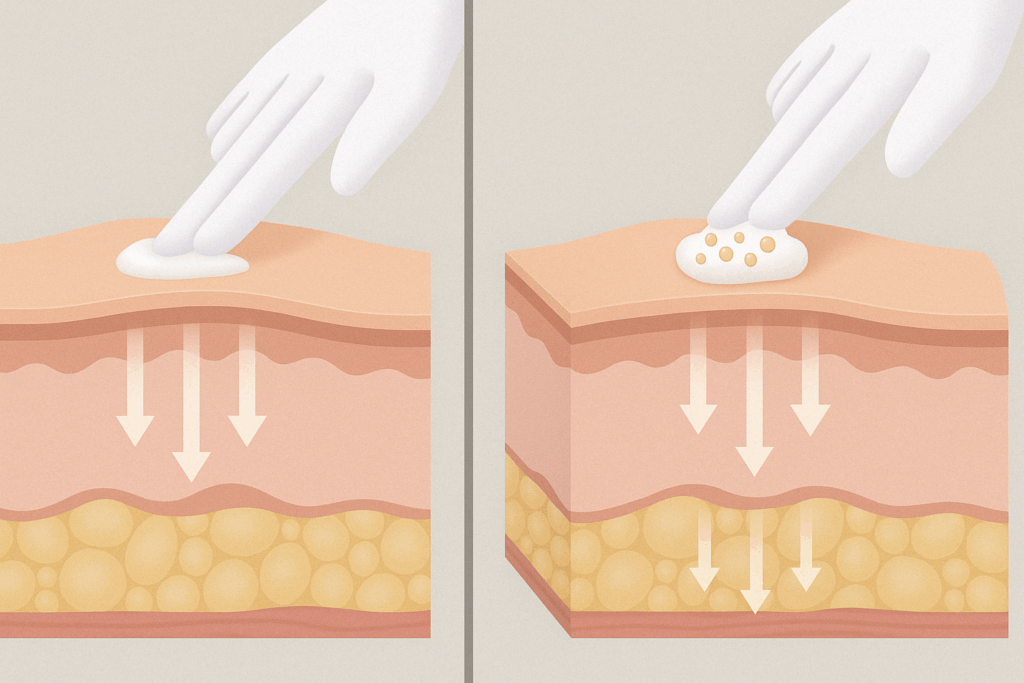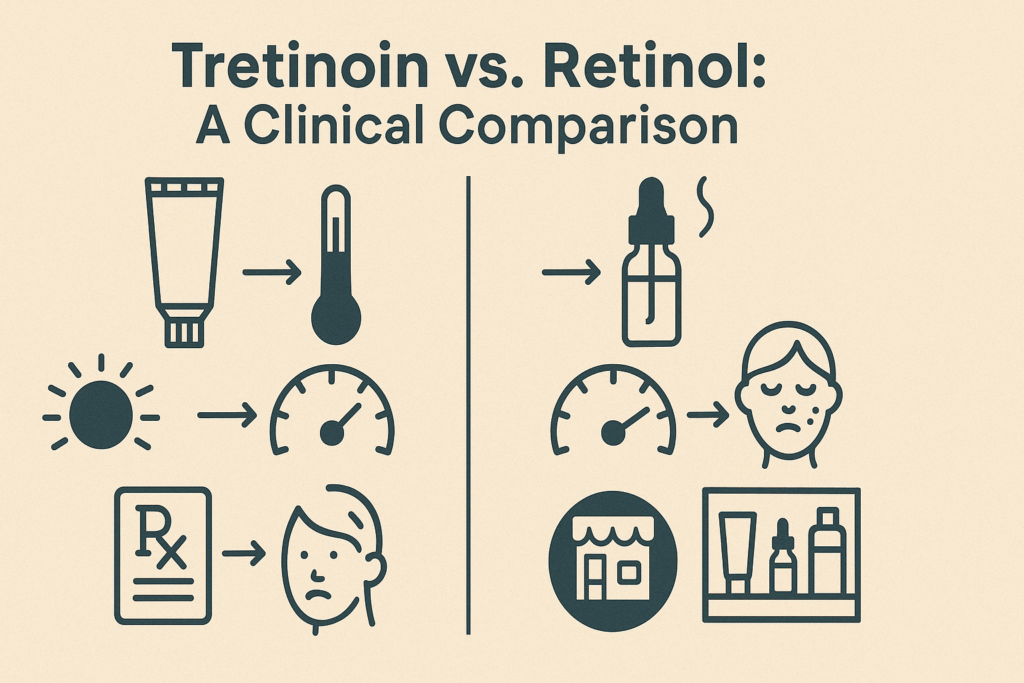In the ever-evolving world of skincare, few ingredients have stood the test of time as steadfastly as retinoids. From reducing fine lines to reversing photoaging and minimizing acne, these compounds are widely revered in both clinical dermatology and over-the-counter beauty care. Yet despite their ubiquity, confusion often surrounds the distinctions between tretinoin, retinol, and branded formulations like Retin-A and Retin-A Micro. This lack of clarity not only hampers consumers’ ability to make informed choices, but also leads to improper use that can trigger side effects or diminish therapeutic outcomes. For those seeking to understand how these powerful agents work and how to use them safely, the first step is to demystify their identities and uses.
You may also like: How to Choose Skin Care for Fine Lines: Evidence-Based Tips for Healthier, Younger-Looking Skin

Retinoids, in the broadest sense, refer to a class of compounds derived from vitamin A. These include both natural and synthetic forms, each varying in potency, penetration, and pharmacological activity. Retinol is the most commonly known and widely available over-the-counter retinoid. Tretinoin, on the other hand, is a prescription-strength version of retinoic acid—the active form that directly affects skin cell behavior. When consumers ask, “is Retin-A the same as tretinoin,” the answer is nuanced but fundamentally rooted in biochemistry. Retin-A is a brand name for tretinoin; therefore, while all Retin-A products contain tretinoin, not all tretinoin formulations are branded as Retin-A. This distinction is critical for understanding therapeutic outcomes and how product formulations influence skin absorption and tolerability.
To appreciate the mechanisms behind these agents, one must delve into how they interact with the skin. Retinol, though popular in many cosmetic formulations, is not biologically active in its initial state. Once applied, it undergoes a multi-step conversion process in the skin—first to retinaldehyde, then finally to retinoic acid. This two-step oxidation reduces its potency but also lowers its risk of irritation, making it a suitable option for those with sensitive skin or those new to retinoids. In contrast, tretinoin—whether as generic tretinoin or in branded forms like Retin-A and Retin-A Micro—is already in its active state. This enables it to act more directly and efficiently on the skin, stimulating collagen synthesis, accelerating cellular turnover, and regulating sebum production. However, this potency also increases the risk of adverse effects such as peeling, redness, and initial breakouts.

Understanding the distinction between retinol and tretinoin is essential for individuals navigating skincare options, but it’s equally important to discern the subtle differences between formulations like Retin-A and Retin-A Micro. Though both contain the same active ingredient—tretinoin—they differ significantly in delivery systems. Retin-A is typically suspended in an alcohol-based cream or gel, which allows for rapid penetration into the skin. This formulation can be highly effective but is also more likely to cause irritation, particularly in individuals with dry or sensitive skin types. Retin-A Micro, in contrast, employs a patented microsphere technology that gradually releases tretinoin over time. This slow-release mechanism reduces the intensity of irritation while still delivering effective results. Thus, when comparing Retin-A and Retin-A Micro, consumers should consider not only their skin type but also their tolerance for side effects and their long-term skincare goals.
While these products share a common biochemical heritage, their applications vary based on concentration, delivery method, and individual skin concerns. Dermatologists often prescribe tretinoin to address moderate to severe acne, as it directly targets the follicular epithelium and reduces comedone formation. Retinol, though less potent, remains a mainstay in anti-aging routines due to its ability to gradually improve skin texture and tone with fewer side effects. The question of whether tretinoin retinol comparisons are justified ultimately depends on the user’s therapeutic needs and the context of use. For individuals with more advanced photoaging or persistent acne, tretinoin may offer superior efficacy. However, for those who prioritize maintenance, prevention, or milder correction, retinol may be more appropriate.

Choosing between these options is not simply a matter of strength or branding. It also involves an understanding of how each formulation interacts with different skin types and conditions. For example, those with rosacea or eczema may find tretinoin too harsh and should avoid it unless under medical supervision. On the other hand, individuals with oily, acne-prone skin may benefit more quickly from prescription-strength options. Moreover, the formulation vehicle—whether cream, gel, or microencapsulated suspension—can affect absorption and irritation. This complexity underscores the need for personalized skincare recommendations, ideally guided by a board-certified dermatologist.
There is also a growing body of research exploring the long-term use of these agents. Clinical trials have demonstrated that consistent application of tretinoin significantly improves signs of photodamage, including fine wrinkles, roughness, and hyperpigmentation. In studies comparing tretinoin and retinol, the former consistently showed faster and more dramatic improvements, albeit with higher initial irritation. However, newer formulations and lower dosages have enabled users to benefit from tretinoin’s efficacy with reduced side effects. This has made products like Retin-A Micro increasingly popular among users who seek a balance between potency and comfort. As such, the conversation around “is Retin-A the same as tretinoin” must also account for differences in delivery systems and how they influence therapeutic adherence and outcomes.

The rise in popularity of at-home skincare has further fueled interest in retinoids, but it has also led to misinformation and unsafe usage. A common misconception is that more is better—prompting some individuals to overuse these products in hopes of faster results. This often leads to compromised skin barriers, increased sensitivity, and long-term damage. Both retinol and tretinoin require consistent, measured use, along with diligent sun protection and moisturizing. Even though retinol is less potent, it can still cause irritation if used improperly, particularly in combination with other active ingredients like alpha hydroxy acids (AHAs) or benzoyl peroxide. Tretinoin, being more intense, demands an even greater level of care. Dermatologists recommend beginning with the lowest available strength and gradually increasing frequency as tolerance builds. This process, known as “retinization,” allows the skin to adapt and respond more favorably to treatment.
When introducing these agents into a skincare routine, timing and pairing matter significantly. Nighttime application is universally advised due to the photosensitivity associated with retinoids. Moreover, layering techniques can influence effectiveness. For instance, applying a moisturizer before tretinoin can buffer the skin and reduce irritation, a technique often referred to as “the sandwich method.” On the other hand, applying it directly after cleansing ensures maximum penetration, which may be desirable for thicker, more resilient skin. These strategies are especially important when working with products like Retin-A and Retin-A Micro, as their different formulations interact uniquely with the skin’s natural oils and hydration levels.

The relationship between tretinoin retinol therapies and mental well-being should not be overlooked, especially when considered under the broader umbrella of health and wellness. Skin health is intrinsically tied to self-image, and chronic conditions such as acne or premature aging can have a profound psychological impact. Effective treatment with agents like tretinoin or retinol can significantly enhance self-esteem and reduce the social anxiety often associated with visible skin issues. At the same time, the adjustment period marked by flaking, redness, or purging can temporarily exacerbate emotional stress. For this reason, patients are encouraged to maintain realistic expectations and to consult a professional who can guide them through the process, adjusting the treatment as needed for both physical and psychological comfort.
In addition to aesthetic and emotional benefits, there is emerging interest in the role of retinoids in broader dermatological applications. Beyond acne and aging, tretinoin has shown efficacy in treating melasma, keratosis pilaris, and even certain precancerous lesions such as actinic keratoses. Its ability to normalize epidermal differentiation and reduce atypical keratinocyte proliferation positions it as a cornerstone of preventative dermatology. Similarly, while retinol is not typically used in medical dermatology, its accessibility and safety profile make it an attractive option for early intervention and skin health maintenance. This differentiation further clarifies why understanding the answer to “is Retin-A the same as tretinoin” extends far beyond branding—it involves recognizing pharmacodynamics, clinical indications, and patient-centered care.

Even as consumer interest grows, regulatory distinctions between cosmetic and pharmaceutical retinoids remain critical. In many countries, tretinoin is strictly regulated and available only by prescription due to its potency and potential for misuse. Retinol, on the other hand, is classified as a cosmetic and therefore subject to less oversight. While this makes it more readily accessible, it also opens the door to inconsistent product quality and misleading marketing. Not all retinol formulations are created equal; factors such as concentration, pH, and supporting ingredients can drastically influence effectiveness. This variability reinforces the need for informed purchasing decisions and consultation with healthcare providers, particularly when transitioning between over-the-counter products and prescription-strength therapies.
Ultimately, navigating the landscape of tretinoin, retinol, and Retin-A demands more than casual browsing. It requires an understanding of skin biology, product formulation, and personal health considerations. Whether one is comparing the merits of retin A and retin A micro or weighing the benefits of tretinoin retinol options, the goal should be informed, intentional skincare. The science behind these compounds is robust, but their real-world application hinges on patient education and responsible use. By combining clinical knowledge with practical strategies, users can safely harness the transformative power of retinoids to support long-term skin health and overall well-being.

Choosing the right retinoid is a personalized process, often shaped by skin type, medical history, lifestyle, and tolerance for potential side effects. This journey is best navigated with the guidance of a licensed dermatologist, especially when introducing stronger agents like tretinoin into a regimen. While retinol may serve as a gentle entry point into the world of retinoids, it is not a one-size-fits-all solution. For those who seek greater results and are prepared to manage the transitional challenges, tretinoin—whether generic or in branded forms like Retin-A and Retin-A Micro—can offer unparalleled benefits. The key lies in understanding not only what each product can do but also how it aligns with individual goals and capacities for consistent use.
As awareness grows and more people seek effective, evidence-based skincare, it becomes increasingly important to dispel myths and promote clarity. When consumers ask questions like “is retin a the same as tretinoin,” or seek to compare retin a and retin a micro, they are often on the cusp of a deeper engagement with their health. Addressing these questions with scientifically grounded, accessible information helps build trust and empowers people to make decisions that are both safe and effective. In doing so, we elevate not only the discourse around skincare but also the standard of care available to those who rely on it for both cosmetic and clinical benefits.
Frequently Asked Questions: Tretinoin, Retinol, and Retin-A
1. Can switching between tretinoin and retinol help improve skin tolerance over time?
Yes, transitioning between tretinoin and retinol can serve as a strategic approach to building skin tolerance. Many dermatologists recommend starting with retinol to allow the skin to acclimate to the effects of retinoids before advancing to tretinoin. This method can help minimize the irritation often associated with prescription-strength products. Alternating between the two—especially when initiating treatment—can also reduce the risk of barrier disruption. This strategy can be particularly helpful for individuals who want to explore whether tretinoin retinol regimens are suitable for their long-term skin goals without committing too early to high-potency formulas.
2. What factors should be considered when deciding between Retin-A and Retin-A Micro?
The decision between Retin-A and Retin-A Micro often hinges on skin type, sensitivity, and lifestyle. Retin-A delivers a rapid onset of action, which may be ideal for those with oily skin or who need quicker acne reduction. In contrast, Retin-A Micro’s microsphere delivery system offers a gentler release, making it preferable for dry or reactive skin. Individuals concerned about flaking or irritation often report better experiences with Retin-A Micro. When comparing retin a and retin a micro, it’s essential to consider not only skin responsiveness but also how seamlessly the product can be integrated into your broader skincare routine.
3. Is it safe to combine tretinoin with other active ingredients like vitamin C or niacinamide?
While it is possible to use tretinoin alongside vitamin C or niacinamide, timing and layering are key to maintaining skin health and maximizing efficacy. Vitamin C is best applied in the morning due to its antioxidant properties, while tretinoin should be reserved for nighttime use. Niacinamide, on the other hand, pairs well with both and can help mitigate irritation. For those navigating the balance between tretinoin retinol products and complementary actives, establishing a staggered routine can ensure synergy without overstressing the skin. Consulting with a dermatologist can provide clarity on the best sequence for these combinations.
4. How does the skin microbiome respond to prolonged use of tretinoin or retinol?
Emerging research suggests that long-term retinoid use may influence the skin microbiome by altering pH and increasing cellular turnover. This shift can initially disrupt the balance of commensal bacteria, potentially leading to transient irritation. However, with consistent application, the skin often recalibrates, and many users experience improved clarity and reduced inflammation. In tretinoin retinol treatments, maintaining a supportive skincare routine that includes probiotics or gentle, microbiome-friendly cleansers can aid in restoring equilibrium. Understanding this interaction underscores the importance of holistic skin care when using potent topical agents.
5. Are there differences in how various ethnic skin types react to Retin-A and Retin-A Micro?
Yes, melanin-rich skin may react differently to retinoids compared to lighter skin tones. Hyperpigmentation, post-inflammatory dark spots, and sensitivity are more pronounced concerns among individuals with darker complexions. Retin-A Micro is often better tolerated due to its slow-release formulation, which reduces the likelihood of irritation-induced discoloration. When weighing retin a and retin a micro options for skin of color, it’s advisable to start with a lower concentration and pair it with barrier-repairing moisturizers. Personalized guidance from a dermatologist who is experienced with diverse skin types is especially valuable in these cases.
6. Does diet impact how well tretinoin or retinol works?
While topical application is the primary mode of action, diet can play a supportive role in retinoid effectiveness. Nutrients such as zinc, vitamin E, and omega-3 fatty acids contribute to skin healing and resilience, enhancing the skin’s response to treatment. Dehydration and high sugar intake, conversely, can exacerbate dryness or inflammation associated with retinoid use. Individuals pursuing a tretinoin retinol routine may benefit from a skin-supportive diet that emphasizes hydration and antioxidant-rich foods. Although not a replacement for topical products, dietary choices can significantly enhance their visible benefits.
7. How do hormonal changes affect the efficacy of tretinoin and retinol?
Hormonal fluctuations, particularly those related to menstruation, pregnancy, or menopause, can influence how the skin reacts to active ingredients. During periods of hormonal imbalance, the skin may become more sensitive or prone to breakouts, altering its tolerance to both tretinoin and retinol. Some users find that their usual regimen becomes irritating or ineffective during these times. For those wondering whether tretinoin retinol routines should be adjusted in response to hormonal shifts, temporary dosage reductions or increased moisturization may help. Always consult a healthcare provider before continuing tretinoin during pregnancy, as it is contraindicated in that context.
8. Can tretinoin or Retin-A be safely used after cosmetic procedures like microneedling or chemical peels?
Using tretinoin or Retin-A after cosmetic treatments requires caution and proper timing. Skin is often more vulnerable post-procedure, and applying retinoids too soon can trigger severe irritation or impede healing. Most dermatologists recommend pausing tretinoin for at least 3–7 days before and after invasive treatments. When resuming use, starting with Retin-A Micro may ease the transition, as its gradual release is less likely to provoke adverse reactions. Understanding whether is retin a the same as tretinoin becomes particularly important here, as product strength and formulation directly affect post-treatment outcomes.
9. What psychological effects can result from starting a retinoid regimen, especially in acne-prone individuals?
Beginning a retinoid routine, particularly with tretinoin or Retin-A, can be emotionally challenging, especially for those with acne-prone skin. Initial purging phases—where breakouts may worsen before improving—can lead to feelings of discouragement or self-consciousness. This emotional toll is often underestimated, yet it can significantly impact adherence. Knowing in advance that such a phase is temporary helps users maintain perspective and stay committed. Clear communication around whether is retin a the same as tretinoin and how side effects may evolve can empower individuals and improve both psychological resilience and treatment success.
10. What innovations are on the horizon for retinoid delivery systems?
Advancements in delivery technology are shaping the future of topical retinoids, with the goal of improving efficacy while minimizing irritation. New microencapsulation methods, similar to what’s seen in Retin-A Micro, are being refined to offer more controlled release and targeted penetration. Other innovations include polymer-based delivery matrices and liposomal carriers that enhance skin absorption without compromising the barrier. As more consumers seek clarity on questions like “is retin a the same as tretinoin,” understanding how formulation science evolves becomes critical. These emerging technologies promise to make tretinoin retinol therapies more accessible and tolerable for a broader range of users.
A Final Word on Choosing the Right Retinoid for Long-Term Skin Health
As this exploration reveals, the nuanced differences between tretinoin, retinol, and products like Retin-A and Retin-A Micro are not merely semantic—they are crucial to achieving safe and effective skincare outcomes. Whether you are comparing tretinoin retinol options for general maintenance or trying to decide between retin a and retin a micro for targeted treatment, the most successful outcomes begin with education. Understanding that Retin-A is a branded form of tretinoin helps clarify that the question “is retin a the same as tretinoin” is more than just a labeling concern; it reflects a need to understand concentration, formulation, and delivery system.
Safe and effective use of these agents also requires attention to skin compatibility, timing, and complementary care strategies. Incorporating SPF, avoiding harsh exfoliants, and giving the skin time to adjust are critical components of any retinoid regimen. For users navigating the choice between tretinoin retinol pathways, long-term success lies not in immediate results but in consistency and patience. The beauty of retinoids lies in their cumulative effect—steady, science-backed progress that supports not just aesthetic goals, but holistic skin wellness. In this context, the right product is not simply the strongest, but the one that aligns most closely with individual needs, preferences, and dermatological advice. As interest in dermatologic health continues to expand, so too should our commitment to understanding the tools at our disposal, empowering each person to make confident, informed decisions for their skin.
Was this article helpful? Don’t let it stop with you. Share it right now with someone who needs to see it—whether it’s a friend, a colleague, or your whole network. And if staying ahead on this topic matters to you, subscribe to this publication for the most up-to-date information. You’ll get the latest insights delivered straight to you—no searching, no missing out.
Further Reading:
Retinol vs. Tretinoin: Benefits, Side Effects, Uses, More
Retinol vs. Retin-A (Tretinoin): What’s the Difference?
Retinal in Skincare, Comparing it with Retinol and Tretinoin
Disclaimer
The information contained in this article is provided for general informational purposes only and is not intended to serve as medical, legal, or professional advice. While Health11News strives to present accurate, up-to-date, and reliable content, no warranty or guarantee, expressed or implied, is made regarding the completeness, accuracy, or adequacy of the information provided. Readers are strongly advised to seek the guidance of a qualified healthcare provider or other relevant professionals before acting on any information contained in this article. Health11News, its authors, editors, and contributors expressly disclaim any liability for any damages, losses, or consequences arising directly or indirectly from the use, interpretation, or reliance on any information presented herein. The views and opinions expressed in this article are those of the author(s) and do not necessarily reflect the official policies or positions of Health11News.